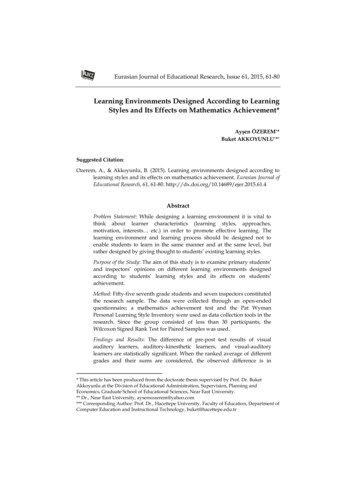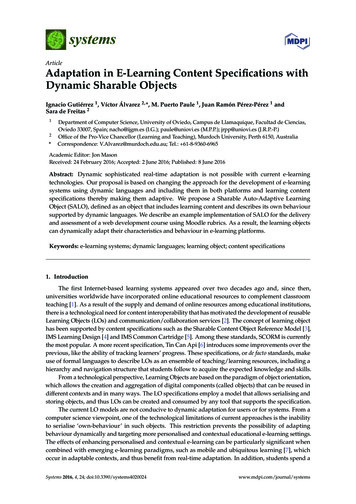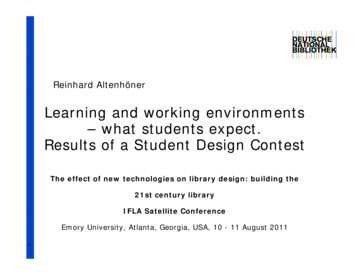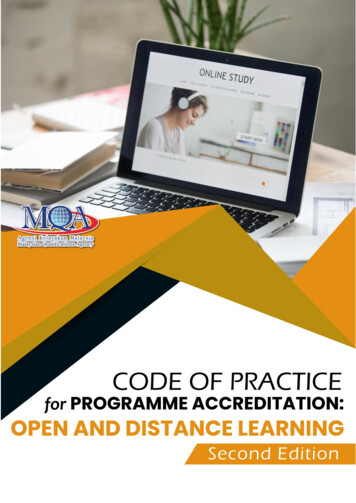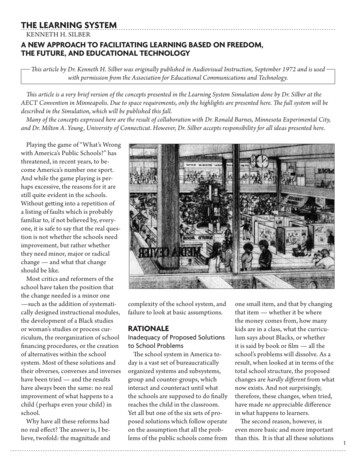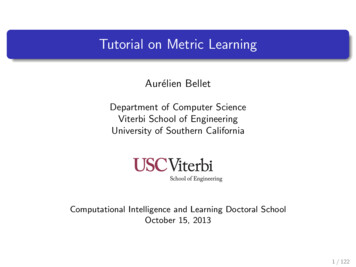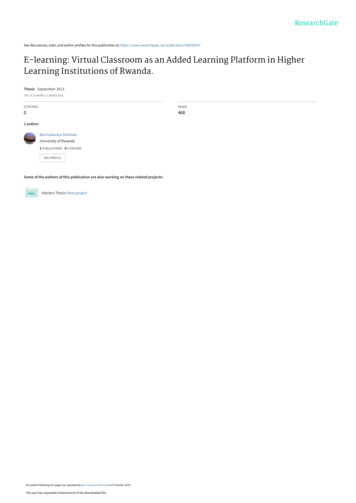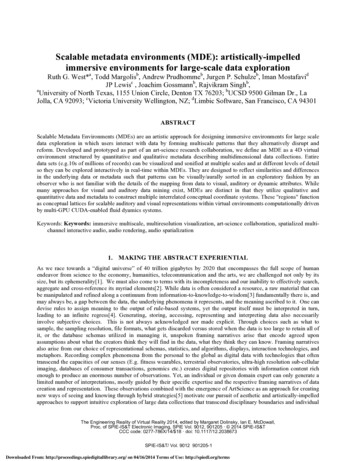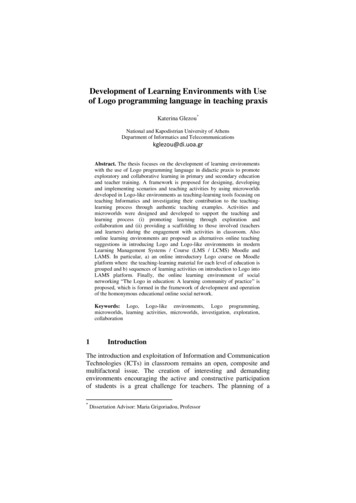
Transcription
Development of Learning Environments with Useof Logo programming language in teaching praxisKaterina Glezou*National and Kapodistrian University of AthensDepartment of Informatics and Telecommunicationskglezou@di.uoa.grAbstract. The thesis focuses on the development of learning environmentswith the use of Logo programming language in didactic praxis to promoteexploratory and collaborative learning in primary and secondary educationand teacher training. A framework is proposed for designing, developingand implementing scenarios and teaching activities by using microworldsdeveloped in Logo-like environments as teaching-learning tools focusing onteaching Informatics and investigating their contribution to the teachinglearning process through authentic teaching examples. Activities andmicroworlds were designed and developed to support the teaching andlearning process (i) promoting learning through exploration andcollaboration and (ii) providing a scaffolding to those involved (teachersand learners) during the engagement with activities in classroom. Alsoonline learning environments are proposed as alternatives online teachingsuggestions in introducing Logo and Logo-like environments in modernLearning Management Systems / Course (LMS / LCMS) Moodle andLAMS. In particular, a) an online introductory Logo course on Moodleplatform where the teaching-learning material for each level of education isgrouped and b) sequences of learning activities on introduction to Logo intoLAMS platform. Finally, the online learning environment of socialnetworking “The Logo in education: A learning community of practice” isproposed, which is formed in the framework of development and operationof the homonymous educational online social network.Keywords: Logo, Logo-like environments, Logo programming,microworlds, learning activities, microworlds, investigation, exploration,collaboration1IntroductionThe introduction and exploitation of Information and CommunicationTechnologies (ICTs) in classroom remains an open, composite andmultifactoral issue. The creation of interesting and demandingenvironments encouraging the active and constructive participationof students is a great challenge for teachers. The planning of a*Dissertation Advisor: Maria Grigoriadou, Professor
learning environment includes extensive decision making forplanning, which should be the result of conscious thought rather thanan unconscious choice ([27], [4], [6]). Learning occurs through aprocess of continuous changes in the individual’s cognitive structuresand is directly linked to the effects of the sociocultural environment[28]. At the same time, the context in which learning takes place[24], as well as the tools’ mediation [28] play a crucial part providingopportunities for active, exploratory and personally significantlearning for the individual.Logo is considered an important tool in the hands of teachers andstudents for the development of their exploration skills, creativityskills and problem solving skills and for the cultivation of logicalalgorithmic reasoning ([24], [16], [2], [18], [17], [3], [26], [5]). Thetrainees become, at the same time, users and designers as they designand construct tools and objects for the solution of problems. Thisdouble role of the trainees leads directly to the notion ofconstructionism. Constructionism involves two interweaving types ofconstruction: knowledge construction through construction ofartifacts with personal meaning ([16], [18]).Logo-like environments can be used to plan and developmicroworlds that offer students the possibility to express and exploittheir thoughts, ideas and instincts and support the process of buildingknowledge by creating learning environments rich in speculation andopportunities for experimentation ([17], [26]).The microworld concept has been present for over four decadesnow and the exploitation of microworlds in education has triggeredthe interest and attention of many researchers and instructors, whoplan, experiment with and explore alternative constructionistapproaches in various thematic fields ([18], [5], [6], [19], [20], [21],[22], [23], [1], [2], [25]).In this context, the research focuses on the development oftechnologically supported learning environments through the use ofLogo as a programming language and philosophy of education, thatsupports exploratory and collaborative learning in primary andsecondary education and teacher training.Central research topic was the design, development,implementation and evaluation of teaching scenarios, activities andmicroworlds developed in Logo-like learning environments topromote exploratory and collaborative learning and exploring theircontribution to the teaching-learning process. Also, an importantresearch topic was the development of online learning environmentsas alternative online teaching suggestions in introducing Logo andLogo-like environments towards promoting communication,
interaction and collaboration among members of the educationalcommunity.The remainder of this paper is organized as follows. In Section 2,a framework for designing, developing and implementing scenariosand teaching activities by using microworlds developed in Logo-likeenvironments is presented. In Section 3, online learningenvironments are presented as alternatives online teachingsuggestions in introducing Logo and Logo-like environments inmodern Learning Management Systems / Course (LMS / LCMS)Moodle and LAMS. Following, in Section 4, the online learningenvironment of social networking “The Logo in education: Alearning community of practice” is presented. Finally, conclusionsare given in Section 5, with the main points of the research and itscontribution in the specific research area.2A framework for designing, developing andimplementing scenarios and teaching activities by usingmicroworlds developed in Logo-like environmentsA framework is proposed for designing, developing andimplementing scenarios and teaching activities by using microworldsdeveloped in Logo-like environments (for example MicroWorldsPro, Xelonokosmos/E-Slate) as teaching-learning tools focusing onteaching Informatics and investigating the contribution of these in theteaching-learning process through authentic teaching examples.Educational scenarios, activities and microworlds were designedand developed to support the teaching - learning process in primaryand secondary education and teacher training (i) promoting learningthrough exploration and collaboration and (ii) providing a scaffoldingto those involved (teachers and learners) during the engagement withactivities in classroom ([8], [11], [12], [14], [15]).abcdFig. 1. Snapshots of the “Free fall simulation development” preconstructedmicroworld.
The basic axes for the design of educational scenarios andactivities suggested are: a) structuring exploratory roles, b)supporting the process of active knowledge building, c) exploitingstudents’ previous knowledge, experiences and intuitions, d)developing new student-teacher roles, e) creating collaborativelearning environments, and f) using a cross-thematic approach.Fig. 2. Snapshots of the “Free fall simulation development” students’project work microworld.The Investigation Course functions as a framework for theintroduction and exploitation of microworlds in the classroom,focusing on alternative forms of exploration, knowledge structuring,expression, collaboration and communication for students andteachers [15]. The activities of the Investigation Course offer richopportunities for experimentation, formulation and testinghypotheses, interpreting and shaping ideas by placing emphasis onthe development of high level reasoning and problem solving skills.Fig. 3. Snapshots of “The Peace Symbol” students’ microworlds.The following are stressed as particular focal points of theInvestigation Course: a) emphasis is given to the process and not tothe end product, b) students’ intuition is cultivated and exploited, c)students’ thoughts and ideas are visualized, d) students exploit theirmistakes and are led to the depenalization of the mistake, e) new
problem solving strategies develop, such as the analysis of theproblem in different parts, f) students make original artifacts ofpersonal interest and meaning. Taking into consideration theparticular students’ previous knowledge and experience level, thestarting point and the task’s course are different each time, having asbasic guiding axes the fact that we gradually move to the writing ofan increasingly difficult code: a) to the familiarization with simpleLogo commands, b) to using the simple and composite repetitioncommand, c) to defining procedures, d) to defining superprocedures,e) to introducing the concept of variable and the definition ofparametric procedures and f) to defining parametric Logosuperprocedures.Fig. 4. Snapshots of a microworld, while working out activity with agradually increasing degree of complexity (Stages 2-3).Fig. 5. Snapshots of a microworld, while working out activity with agradually increasing degree of complexity (Stages 4-5).It also proposes an alternative constructionist training approach forthe introduction to Logo programming by using a structured series ofactivities and preconstructed reusable microworlds developed in themultimedia programming environment MicroWorlds Pro. Theproposed approach and material aims to scaffold the gradualfamiliarization of the trainees with Logo –programming language andphilosophy of education- and the programming environment byapplying in action the constructionist reasoning ([9], [10], [13]). Thetraining material is characterized by a gradual increase in complexity
and difficulty degree, and exploits the gradually acquired experienceof the trainees by providing them with tools that they are in positionto use.The preconstructed microworlds functioned as “objects to thinkwith”, a good starting point and a solid ground for explorationsmodifications-extensions, as a vehicle for collaboration and led tovarious alternative constructions of personal and social meaningfulartifacts. The use and re-use of preconstructed microworlds for thecreation of new artifacts with a gradually increasing degree ofcomplexity encourages the systematization of knowledge and bridgesthe gap between the simple and the more complex ([8], [9], [10],[13]).3Development of online learning environmentsOnline learning environments are proposed as alternatives onlineteaching suggestions in introducing Logo and Logo-likeenvironments in modern Learning Management Systems / Course(LMS / LCMS) Moodle and LAMS. In particular, a) an onlineintroductory Logo course on Moodle web platform where is groupedthe teaching-learning material for each level of education and b)sequences of learning activities on introduction to Logo into LAMSplatform.The special features of online learning environments create newconditions for learning and demonstrate a variety of new possibilitiesfor alternative forms of communication, interaction and cooperationby supporting collaborative learning. Both online learningenvironments are emerging as convenient and friendly webdevelopment tools of learning environments that support activeparticipation and promote communication, interaction andcollaboration between stakeholders (teachers and learners). They aredifferent platforms with specific features each and a totalbenchmarking is not feasible. The teacher emerges as the catalystacting on the teaching strategy that will follow and support throughthe tool and in this way will add value to the pedagogical use oftechnology. Nevertheless it is considered that by using the LearningManagement System / Courses Moodle more emphasis is given oncontent delivery, while by using the Learning Activity ManagementSystem LAMS more emphasis is placed on interaction andcooperation.
Fig. 6. Snapshot of an online introductory Logo course on Moodle platform.Fig. 7. Snapshot of a sequence of learning activities on introduction to Logointo LAMS platform.4Development of the online learning environment ofsocial networking “Logo in education: A learningcommunity of practice”The online learning environment of social networking “Logo ineducation: A learning community of practice” (“LogoinEdu” asabbreviation) is proposed, which is formed in the framework ofdevelopment and operation of the homonymous educational onlinesocial network (“EOSN” as abbreviation). This EOSN is functioningas a learning community of practice and as a step for dialogue andmutual support of the educational community in the effort to upgradethe teaching - learning process [7]. Its goal is the communication,cooperation and exchange of views, ideas and material betweenmembers of the educational community from different fields, age andbackground, who are fond of Logo programming language andphilosophy in education.
The network primarily concerns teachers of Informatics andComputer Science and in parallel, teachers of various specialties,cognitive subjects and all educational levels who are interested inor/and experimenting with the usage of Logo programming languagein the teaching praxis. As it is denoted in the “LogoinEdu” subtitle“Learn - Construct - Collaborate - Communicate” the ulteriorobjective of “LogoinEdu” is to function as a learning community ofpractice, as a forum for the dialogue and mutual support betweenmembers of the educational community focusing on the pedagogicalexploitation of Logo and Logo-like environments attempting toimprove the teaching-learning process. The network members areinvited to interact in the spirit of Social Constructionism: “Let’sfunction as a community of practice and learning and exchangeviews, experiences, practices and tools, such as microworlds,websites, lesson plans, worksheets, codes and all kinds of resourcesnecessary for our teaching practice, with the purpose to upgrade theteaching-learning process.” as it is characteristically mentioned in thenetwork pages.Fig. 8. Snapshot of home page of the “Logo in education: A learningcommunity of practice” educational online social network.5ConclusionsThe research presented contributes to the fields of didactics ofinformatics, and especially of didactics of Logo programming as wellas of computer-supported collaborative learning. The main
contribution of the work lies in the provision of a framework and inthe development of Logo-based learning environments that supportthe construction of knowledge and promote synchronous andasynchronous communication and collaboration.It proposes a framework for designing, developing andimplementing scenarios and teaching activities by using microworldsdeveloped in Logo-like environments as teaching-learning toolsfocusing on teaching Informatics and investigating the contributionof these to the teaching-learning process through authentic teachingexamples. Activities and microworlds were designed and developedto support the teaching and learning process (i) promoting learningthrough exploration and collaboration and (ii) providing a scaffoldingto those involved (teachers and learners) during the engagement withactivities in classroom.Online learning environments are proposed as alternatives onlineteaching suggestions in introducing Logo and Logo-likeenvironments in modern Learning Management Systems: a) anonline introductory Logo course on Moodle platform where isgrouped the teaching-learning material for each level of educationand b) sequences of learning activities on introduction to Logo intoLAMS platform. Finally, the online learning environment of socialnetworking "The Logo in education: A learning community ofpractice is proposed. The network is functioning as a learningcommunity of practice and as a step for dialogue and mutual supportof the educational community in an effort to upgrade the teaching learning process.The studies conducted, revealed encouraging and positive resultsfor the above mentioned environments in serving their underlyingobjectives and in supporting the learning process.The structured teaching/training material exploited in gradualsteps and according to the acquired experience of thestudents/trainees could be considered especially effective inintroducing Logo programming and in gradual familiarization withthe programming environment; it may be adapted/extended toindividual needs and may be used in different learning contexts.The preconstructed microworlds functioned as a good startingpoint, as a solid ground for explorations-modifications-extensions, asa vehicle for collaboration and led to various alternativeconstructions of personal and social meaningful artifacts. The use ofpreconstructed microworlds for the construction of new artifacts witha gradually increasing degree of complexity encourages thesystematization of knowledge and bridges the gap between thesimple and the more complex.
The proposed framework and corresponding learningenvironments support exploratory and collaborative learning andcontribute to the active involvement of stakeholders (teachers andlearners), the construction of knowledge in programming conceptsand cultivation of programming, expression and collaboration skills.References[1] Brouwer, N., Muller, G. & Rietdijk, H. (2007). Educational Designingwith MicroWorlds. Journal of Technology and Teacher Education. 15(4), pp. 439-462. Chesapeake, VA: AACE.[2] Clements, D. H., & Meredith, J.S. (1993). Research on Logo: Effectsand efficacy. Journal of Computing in Childhood Education, 4, 263290.[3] Dagiene, V. (2003). A set of Logo problems for learning algorithms.In Proceedings of Eurologo 2003. Edited by Cnotinfor, Lda. Porto,August.168-177.[4] Dimitracopoulou, A. & Komis, V. (2005). Design principles for thesupport of modelling and collaboration in a technology-based learningenvironment. Int. J. Cont. Engineering Education and LifelongLearning, Vol. 15, Nos. 1/2, 30–55.[5] diSessa, Α. (1995). Epistemology and Systems Design, In diSessa, Α.- Hoyles C., Computers and Exploratory Learning, Springer Verlag,15-29.[6] diSessa, A. (2000). Changing minds: Computers, learning, andliteracy. Cambridge, MA: MIT Press.[7] Glezou, K., Grigoriadou M., & Samarakou, M., (2010). EducationalOnline Social Networking in Greece: A Case Study of a GreekEducational Online Social Network. The International Journal ofLearning, Volume 17, Issue 3, pp. 399-420.[8] Glezou, K. & Grigoriadou M., (2010). Engaging Students of SeniorHigh School in Simulation Development. INFORMATICS INEDUCATION, 2010, Vol. 9, No. 1, pp. 37-62.[9] Glezou, K. & Grigoriadou M., (2010). Teacher Training in LogoProgramming by using Preconstructed Reusable Microworlds. TheInternational Journal of Learning, Volume 17, Issue 1, pp. 347-364.[10] Glezou, K. & Grigoriadou, M. (2009). An Alternative InstructionalApproach for Introductory Courses to Logo Programming. InProceedings of IADIS International Conference CELDA 2009, pp.419-424. Rome, Italy.[11] Glezou, K. & Grigoriadou, M. (2009). Supporting StudentEngagement in Simulation Development. In C. O’Malley, D. Suthers,P. Reimman, A. Dimitracopoulou (Eds.) Proceedings of 8thInternational Conference on Computer Supported Collaborative
Learning CSCL2009: Computer Supported Collaborative LearningPractices, pp. 414-418. Rhodes.[12] Glezou, K. & Grigoriadou M. (2009). Design Principles of TrainingMaterial for Introductory Courses to Programming and Logo by usingpreconstructed microworlds. In Proceedings of World Conference onEducational Multimedia, Hypermedia and Telecommunications 2009(ED-MEDIA 2009), pp. 1606-1614. Chesapeake, VA: AACE.[13] Glezou, K. & Grigoriadou, M. (2008). Simulation Development byStudents: An Alternative Cross-Thematic Didactical Approach. InProceedings of World Conference on Educational Multimedia,Hypermedia and Telecommunications 2008 (ED-MEDIA 2008), pp.4108-4117. Chesapeake, VA: AACE.[14] Glezou, K. & Grigoriadou, M. (2007). A novel didactical approach ofthe decision structure for novice programmers. In Ivan Kalas (ed.)Proceedings of 11th European Logo Conference (Eurologo 2007),Bratislava.[15] Glezou, K., Grigoriadou M. & Verginis, I. (2009). Rethinking the“Investigation Course” in Primary School. In Ignacio Aedo, NianShing Chen, Kinshuk, Demetrios Sampson, Larissa Zaitseva (Eds.)Proceedings of 9th IEEE International Conference on AdvancedLearning Technologies (ICALT 2009), 554-555, Riga, Latvia.[16] Harel, I. & Papert, S. (1991). Constructionism: Research Reports &Essays, 1985-1990 by the Epistemology & Learning Research Group.Norwood: Ablex Publishing Corporation, US.[17] Hoyles, C., Noss, R. & Adamson, R. (2002). Rethinking themicroworld idea. Journal of Educational Computing Research,27(1&2), pp. 29-53.[18] Kafai, Y. & Resnick, M. (Eds.). (1996). Constructionism in practice:Designing, thinking, and learning in a digital world. Mahwah, NJ:Lawrence Erlbaum Associates.[19] Kalas, I. (2006). Discovering Informatics Fundamentals ThroughInteractive Interfaces for Learning. In R. T. Mittermeir (Ed.), ISSEP2006, LNCS 4226, pp. 13-24.[20] Komis, V. (2005). Introduction in Didactics of Informatics. Athens:Kleidarithmos Publications. (In Greek).[21] Kynigos, C. (2007). Half-baked Microworlds in use in ChallengingTeacher Educatorsʼ Knowing, International Journal of Computers forMathematical Learning. Kluwer Academic Publishers, Netherlands,12 (2), 87-111.[22] Kynigos, C. (2007). Half-Baked Logo Microworlds as BoundaryObjects in Integrated Design, Informatics in Education, 2007, Vol. 6,No. 2, 1-24, Institute of Mathematics and Informatics, Vilnius.[23] Louca, L., Druin, A., Hammer, D. & Dreher, D. (2003). Students’collaborative use of computer-based programming tools in science: ADescriptive Study. In B. Wasson, St. Ludvigsen, & Ul. Hoppe (Eds.).Designing for change in Networked Learning Environments:Proceedings of the CSCL 2003 (pp. 109-118). The Netherlands:Kluwer Academic Publishers.
[24] Papert, S. (1980). Mindstorms: Children, Computers, and PowerfulIdeas. Basic Books, New York.[25] Rieber, L.P. (2004). Microworlds. In Handbook of research foreducational communications and technology (2nd ed.), D. Jonassen(Ed.), Mahwah, NJ: Lawrence Erlbaum Associates, 583-603.[26] Resnick, M., Maloney, J., Monroy-Hernández, A., Rusk, N.,Eastmond, E., Brennan, K., Millner, A., Rosenbaum, E., Silver, J.,Silverman, B., Kafai, Y., (2009). Scratch: Programming for All,November 2009, Communications of the ACM, 52(11), pp. 60-67.[27] Vosniadou, S. (2005). Planning learning environments supported bymodern technologies, Athens, Gutenberg Publications. (In Greek).[28] Vygotsky, L.S. (1978). Mind in Society: The development of HigherPsychological Processes, Harvard University Press, Cambridge,Massachusetts.
Learning Management Systems / Course (LMS / LCMS) Moodle and LAMS. In particular, a) an online introductory Logo course on Moodle . Nevertheless it is considered that by using the Learning Management System / Courses Moodle more emphasis is given on content delivery, while by using the Learning Activity Management

